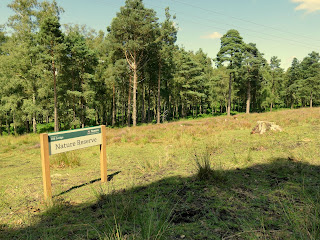This colourful spider came into my kitchen with some hazel nuts. Crab spiders are amazing with colour combinations matching their plant or flower location.
For two years I have taken a special interest in spiders and created an illustrated talk, which is described at http://www.peterlovetttalks.co.uk/page14.html
For illustrated talks on natural history and history see www.peterlovetttalks.co.uk
For illustrated talks on natural history and history click here for www.peterlovetttalks.co.uk
Monday, 28 August 2017
Cuckfield vineyards walk, about 5 miles.
It is this extraordinary change in land use that prompts me to share this walk with you. It is an easy walk to navigate. From Cuckfield take the High Weald landscape trail (HWLT) westwards, with great views to the South Downs and Wolstonbury Hill, to Deaks Lane.
 |
| View to the South Downs |
 |
| Wolstonbury Hill zoomed in. |
You are now in the c.100 acres of Pookchurch vineyard, http://www.pookchurch.co.uk/#pookchurch
Take the footpath through the vineyard and a wood to Broxmead Lane. There turn right up the hill and under the canopy of a magnificent chestnut tree, which sheds yummy chestnuts on the road in some years. At Broxmead a footpath to the right takes you through more vineyards to Deaks Lane.
(If you come to a locked gate you have missed the public footpath which dives off through the hedge, a few metres behind you, to Deaks lane alongside houses and gardens.)
 |
| As you leave Broxmead Lane |
 |
| View to Cuckfield church |
 |
| View to Cuckfield church |
 |
| Chanctonbury Hill |
Unfortunately, this path is now getting overgrown since I stopped regularly clearing it.
Please see https://sussexrambler.blogspot.co.uk/2011/07/path-clearing-on-high-weald-landscape.html
for the situation in 2011.
How wonderful it would be if other Cuckfield residents now assumed path clearing of this beautiful trail. Local and long distance walkers would be grateful.
Tuesday, 15 August 2017
Cuckoos have left the UK, yet cuckoos remain.
Buddleia or butterfly bushes are visited not just by butterflies but also by bees.
 |
| Red Admiral |
 |
| Large White |
 |
| Comma |
 |
| Buff-tailed bumblebees |
For example, here are a couple of Buff-tailed bumblebees, Bombus terrestris. The larger, with a buff coloured tail is a queen. The smaller, with a white abdominal tip is a worker or a male.
 |
| Buff-tailed bumblebees |
 |
| Southern Cuckoo bee |
On this same bush yesterday in my West Sussex garden was a Southern cuckoo bee, Bombus vestalis, which is a parasite of Buff-tailed bumblebees.
 |
| Southern cuckoo bee and a honey bee |
 |
| Buff-tailed bumblebee queen (foreground) and a cuckoo bee (top) |
Just like the cuckoo bird, cuckoo bumblebees lay their eggs in a host bee's nest, which is cuckolded into rearing the cuckoo bee's progeny.
Bumblebees and honey bees are vital pollinators of plants. Solitary bees play an even greater role.
Advice for gardeners wishing to maintain a bee-friendly garden is avaiable from the Bumblebee Conservation Trust at https://bumblebeeconservation.org/get-involved/gardening-for-bees/
"The extraordinary lives of wild bees and the important role of gardeners in their survival" is one of my talks on natural history, details of which are at http://www.peterlovetttalks.co.uk/page15.html
All these photo's were taken in my garden yesterday, 14 August 2017. Click on any picture to expand it. For my other talks please see http://www.peterlovetttalks.co.uk/
Monday, 14 August 2017
Six Dragonfly and Damselfly species in the Sussex High Weald yesterday.
A perfect location for White-legged damselflies, which although uncommon, were numerous here yesterday.
Click on any picture to expand it.
For info' on my talk on these fascinating insects click here
 |
| White-legged Damselfly |
 |
| White-legged Damselfly |
 |
| Common Blue damselfly male |
 |
| Common Blue damselflies mating wheel. |
 |
| Azure Damselfly male |
 |
| Common Darter |
 |
| Black-tailed Skimmer perhaps |
 |
| Male Brown Hawker |
For info' on my talk on these fascinating insects click here
Wednesday, 2 August 2017
Southern Hawker Dragonfly newly emerged at Old Lodge, nature reserve, Ashdown forest, yesterday
There is something hanging from the bracing strut under the bridge.
It looks like a newly emerged Southern Hawker Dragonfly, Aeshna cyanea |
| Southern Hawker Dragonfly, Aeshna cyanea |
 |
| Southern Hawker Dragonfly, Aeshna cyanea |
I went back later at 15.00hr to see how it was getting on.
I had to kneel on the bridge and hold my camera over the water without dropping it.
It was quite dark and the shutter speed was too slow for a sharp image on close-up macro mode. A flash was used to get these shots.
All photo's are copyright Peter Lovett.
Click the pictures to enlarge them.
Click here for details of my illustrated talk on these fascinating insects.
Subscribe to:
Comments (Atom)















